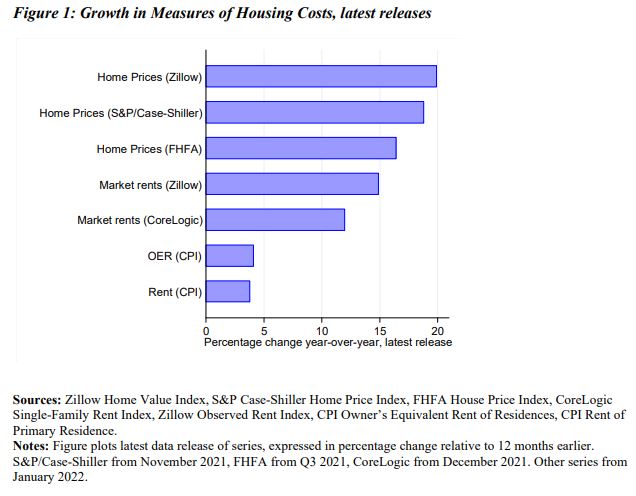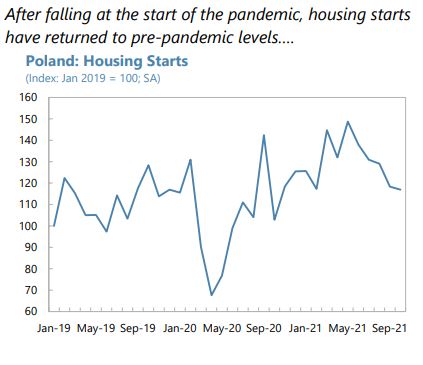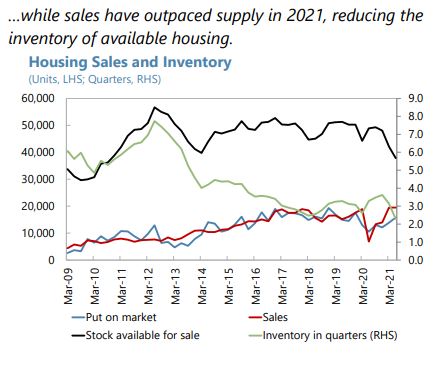Monday, February 28, 2022
The Coming Rise in Residential Inflation
From a new NBER working paper by Marijn A. Bolhuis, Judd N. L. Cramer & Lawrence H. Summers:
“We study how the recent run-up in housing and rental prices affects the outlook for inflation in the United States. Housing held down overall inflation in 2021. Despite record growth in private market-based measures of home prices and rents, government measured residential services inflation was only four percent for the twelve months ending in January 2022. After explaining the mechanical cause for this divergence, we estimate that, if past relationships hold, the residential inflation components of the CPI and PCE are likely to move close to seven percent during 2022. These findings imply that housing will make a significant contribution to overall inflation in 2022, ranging from one percentage point for headline PCE to 2.6 percentage points for core CPI. We expect residential inflation to remain elevated in 2023.”

From a new NBER working paper by Marijn A. Bolhuis, Judd N. L. Cramer & Lawrence H. Summers:
“We study how the recent run-up in housing and rental prices affects the outlook for inflation in the United States. Housing held down overall inflation in 2021. Despite record growth in private market-based measures of home prices and rents, government measured residential services inflation was only four percent for the twelve months ending in January 2022.
Posted by at 6:42 AM
Labels: Global Housing Watch
Saturday, February 26, 2022
PODCAST: Fiscal Policy and Racial Disparities
In conversation with Bill Gale, Arjay and Frances Miller Chair in Federal Economic Policy and senior fellow at the Economic Studies Program, Brookings Institution…
In this episode of Econofact’s podcast, Gill discusses the impact of inequitable racial impacts of government policy. Some notable points include the following:
- Race-blind policies are typically neither race neutral nor race fair because past injustices cast a shadow on current conditions. The absence of racist animus does not mean a policy is not racist.
- The mortgage interest deduction which favors homeowners who are disproportionately wealthier and white is discussed as a case in point to explain the difference between equity and equality.
- He discusses the critical race theory (seemingly race-neutral policies lock in the effects of past racism).
Click here to listen to the full podcast.
In conversation with Bill Gale, Arjay and Frances Miller Chair in Federal Economic Policy and senior fellow at the Economic Studies Program, Brookings Institution…
In this episode of Econofact’s podcast, Gill discusses the impact of inequitable racial impacts of government policy. Some notable points include the following:
- Race-blind policies are typically neither race neutral nor race fair because past injustices cast a shadow on current conditions. The absence of racist animus does not mean a policy is not racist.
Posted by at 9:05 AM
Labels: Inclusive Growth
Friday, February 25, 2022
Housing View – February 25, 2022
On cross-country:
- Analysis: ECB has to fight housing bubble with its hands tied – Reuters
- Owner-occupied housing and inflation measurement – European Central Bank
- A New Angle on Excess Consumption Volatility in Emerging Countries: Does House Price Matter? – Journal of International Money and Finance
- House Prices, Housing Wealth and Financial Well-being – Journal of Urban Economics
On the US:
- Dysfunctional policies have broken America’s housing supply chain – Brookings
- Is There a Way Out of America’s Impossible Housing Mess? The first step, according to economist Jenny Schuetz, is recognizing there is more than one housing crisis. – Slate
- The Housing Boom’s Mortgage Rate Threat Is Worse Than It Seems. Soaring borrowing costs might hurt demand, but they’re not helping supply either. – Bloomberg
- Mortgage Rates Close In on 4%, Making Home Affordability Tougher. Average rate of 30-year fixed loan climbs to highest since May 2019 – Wall Street Journal
- Mortgage Rates Will Rain on This House Party. Housing indicators suggests strong demand and tight supply, but higher mortgage rates are likely to start showing in the data – Wall Street Journal
- Rents Have Soared Across the Country, But Home Prices Grew Even Faster – Harvard Joint Center for Housing Studies
- January Existing Home Sales: Defying Conventional Wisdom – Zillow
- U.S. existing home sales accelerate; investors elbowing out first-time buyers – Reuters
- Wall Street Is Buying Starter Homes to Quietly Become America’s Landlord. Private equity money is pouring into the Phoenix real estate market, turning first-time homebuyers into renters. – Bloomberg
- The Next Affordable City Is Already Too Expensive. In Spokane, Wash., home prices jumped 60 percent in the past two years. The increase is fueled by buyers fleeing the boom in cities like Austin. Who will have to flee next? – New York Times
- Housing: What Fed rate hikes mean for the real estate and rental markets – Yahoo Finance
- Share of all homes bought by investors – Axios
- First-time homebuyers are getting squeezed out by investors – NPR
- Online Real Estate Isn’t Worth the Chance. Even as the housing market booms in the U.S., dreams of online real-estate riches have faded in the stock market – Wall Street Journal
- America’s housing boom is also a backlog – Axios
- Waters Calls on Regulators and Industry to Hold Appraisers Accountable and Announces Plans for Legislation – US House Committee on Financial Services
- Commercial Real Estate Is Seen as an Inflation Hedge, but That Isn’t Always the Case. With inflation running its hottest in four decades, some investors are starting to question the strength of real estate’s defenses against higher prices – Wall Street Journal
- Addressing the Housing Affordability Crisis as COVID-19’s Impact Continues – St. Louis Fed
On China
- China’s Real-Estate Balancing Act. China’s government has emphasized that policies to address financial vulnerabilities and structural problems should not impede economic growth. But, when it comes to the real-estate sector, that will not be an easy balance to strike – and getting it wrong could have economy-wide repercussions. – Project Syndicate
- China Broadens Real Estate Lending Support to Bigger Cities. PBOC urged banks to accelerate property loans in Shanghai. Major banks in Guangzhou cut mortgage rates for homebuyers – Bloomberg
- Is There an Industrial Land Discount in China? A Public Finance Perspective. Local Chinese governments face a trade-off between supplying residential or industrial land, and this work reveals the importance of taxes and revenue streams over time in shaping those choices. – University of Chicago
- Heze Is First Chinese City to Cut Mortgage Down Payments, Local Media Reports. Major banks in Heze cut mortgage down payment ratio to 20%. More smaller cities may follow suit, research analyst says – Bloomberg
- Banks in nearly 90 Chinese cities cut mortgage rates – Reuters
- HSBC takes charge on Chinese real estate and warns of wealth slowdown. Outlook blemishes otherwise buoyant fourth-quarter earnings as profit doubles and targets boosted – FT
On other countries:
- [Australia] House prices and rents surge in regional Australia amid influx of arrivals from cities. Locals say they are being priced out as NAB reports 24 of the 25 largest regions have had double-digit housing growth – The Guardian
- [Colombia] Assessing the impact of recent Venezuelan immigration on housing rents in Colombia – Spatial Economic Analysis
- [Cyprus] Recent developments in housing markets and related policy challenges – Central Bank of Cyprus
- [India] Deepak Parekh Says India’s Real Estate Showing Uptrend Amid Global Jitters – Bloomberg
- [Ireland] Will the price of Irish houses just keep on rising? Cliff Taylor: key policy challenge is to provide a supply of homes at more affordable prices – The Irish Times
- [New Zealand] New Zealand’s homeless have been moved off the streets, but the crisis endures – The Guardian
- [Norway] Norway: boosting productivity and workforce participation while improving housing affordability will help maintain high living standards, says OECD – OECD
- [Spain] Effectiveness and supply effects of high-coverage rent control policies – Barcelona Institute of Economics
- [Taiwan] Long- and short-term price behaviors in presale housing markets in Taiwan – Economic Analysis and Policy
- [Turkey] Turkish builder touts land sales as inflation slows house deals – Reuters
- [United Kingdom] London housing market boosted by end of COVID rules, Rightmove says – Reuters
- [United Kingdom] The Guardian view on unaffordable homes: building injustice into the economy – The Guardian
On cross-country:
- Analysis: ECB has to fight housing bubble with its hands tied – Reuters
- Owner-occupied housing and inflation measurement – European Central Bank
- A New Angle on Excess Consumption Volatility in Emerging Countries: Does House Price Matter? – Journal of International Money and Finance
- House Prices, Housing Wealth and Financial Well-being – Journal of Urban Economics
On the US:
- Dysfunctional policies have broken America’s housing supply chain – Brookings
- Is There a Way Out of America’s Impossible Housing Mess?
Posted by at 5:00 AM
Labels: Global Housing Watch
Thursday, February 24, 2022
Housing Market in Poland
From the IMF’s latest report on Poland:
“The authorities’ proposals to increase housing affordability should consider the impact on the housing market and financial stability. The housing market has returned to pre-pandemic robust conditions (Figure 14). The state development bank plans to offer partial mortgage guarantees in lieu of mortgage down payments to support applicants for smaller mortgage loans, which could increase demand for mortgage loans and fuel further price growth. Mortgages are mostly floating rate, boosting housing affordability during the recent time of extraordinarily low interest rates. However, households could become overstretched as interest rates normalize, risking a deterioration in credit quality. To mitigate these risks, it is important that banks continue conservative creditworthiness assessments in line with supervisory guidelines, including an LTV limit at 80 percent, stressed DSTI at 40–50 percent with an interest rate buffer of 250–300 bps, and loan maturities capped at 25 years. Early signals suggest increasing policy interest rates are likely to dampen demand for mortgage credit.”






From the IMF’s latest report on Poland:
“The authorities’ proposals to increase housing affordability should consider the impact on the housing market and financial stability. The housing market has returned to pre-pandemic robust conditions (Figure 14). The state development bank plans to offer partial mortgage guarantees in lieu of mortgage down payments to support applicants for smaller mortgage loans, which could increase demand for mortgage loans and fuel further price growth.
Posted by at 6:44 AM
Labels: Global Housing Watch
Tuesday, February 22, 2022
Who has the power?
by Alex Tabarrok on February 21, 2022, posted on Margin Revolution.
“The WSJ has several good piece on electric power in the United States, many of which are relevant to my recent podcast with Ezra Klein. Starting with the increased unreliability of America’s electric grid.
The U.S. power system is faltering just as millions of Americans are becoming more dependent on it—not just to light their homes, but increasingly to work remotely, charge their phones and cars, and cook their food—as more modern conveniences become electrified.
… Much of the transmission system, which carries high-voltage electricity over long distances, was constructed just after World War II, with some lines built well before that. The distribution system, the network of smaller wires that takes electricity to homes and businesses, is also decades old, and accounts for the majority of outages.
We need more power but are relying on transmission lines we put into places decades ago when we could still build things. The second WSJ article is on the 17-year travail to get a new power cable from hydropower rich Quebec to Boston.
Blackstone made other discoveries that altered the project. Its environmental consultants spent the summer of 2010 watching patches of blue lupine for endangered Karner blue butterflies and frosted elfins, a threatened species. They spotted two Karners and wrote a plan for avoiding damage to the wildflowers upon which the butterflies rely. Arrangements were also made to protect bald eagle nests that might be present during construction and identify shagbark hickories big enough for the endangered Indiana bat to roost.”
Continue reading here.
by Alex Tabarrok on February 21, 2022, posted on Margin Revolution.
“The WSJ has several good piece on electric power in the United States, many of which are relevant to my recent podcast with Ezra Klein. Starting with the increased unreliability of America’s electric grid.
The U.S. power system is faltering just as millions of Americans are becoming more dependent on it—not just to light their homes, but increasingly to work remotely,
Posted by at 8:07 AM
Labels: Energy & Climate Change
Subscribe to: Posts



